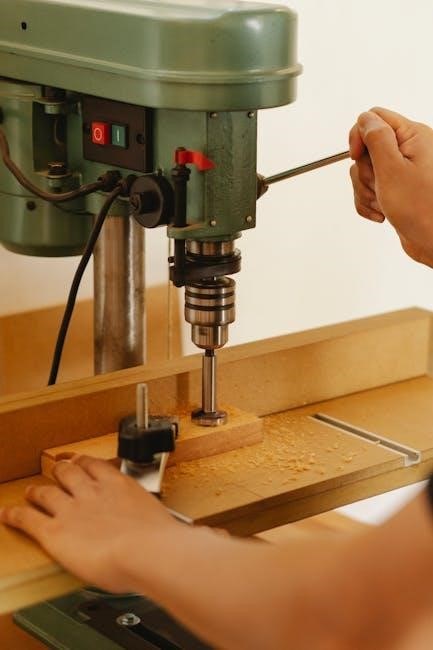Manual material handling equipment refers to tools like hand trucks and dollies, designed to assist in lifting, moving, and transporting goods, enhancing efficiency and reducing physical strain.
Definition and Overview
Manual material handling equipment refers to tools and devices designed to assist humans in lifting, moving, and transporting materials or goods. These devices are typically human-powered, requiring physical effort to operate. Examples include hand trucks, dollies, pallet jacks, and manual lift tables. These tools are essential in industries like warehousing, manufacturing, and logistics, where they help reduce physical strain and improve efficiency. By providing mechanical advantage, they enable workers to handle heavier loads safely and effectively, minimizing the risk of injury and enhancing overall productivity in various operational settings.
Importance in Industrial and Warehouse Settings
Manual material handling equipment plays a vital role in industrial and warehouse operations by enhancing efficiency and reducing physical strain on workers. These tools enable safe and effective movement of goods, preventing injuries and improving productivity. In fast-paced environments, equipment like hand trucks and pallet jacks is essential for streamlining workflows. By minimizing manual lifting, they reduce the risk of workplace accidents and associated costs. Additionally, they are cost-effective solutions for smaller-scale operations, making them indispensable in maintaining smooth logistical processes and ensuring operational efficiency across various industries.

Types of Manual Material Handling Equipment
Manual material handling equipment includes hand trucks, dollies, pallet jacks, and wheelbarrows, which are essential for safely lifting and moving goods efficiently in various industrial environments.
Hand Trucks and Dollies
Hand trucks and dollies are essential manual material handling tools designed to reduce physical strain during lifting and moving tasks. Hand trucks, also known as sack trucks, feature a sturdy frame with handles and wheels, allowing users to transport heavy loads efficiently. Dollies, often with a flat platform or wheels, provide a stable base for carrying items like boxes or equipment. Both tools are versatile, used across industries such as warehouses, retail, and construction. They are cost-effective solutions that enhance productivity while minimizing the risk of injuries associated with manual lifting. Their simplicity makes them indispensable in everyday operations.

Pallet Jacks and Manual Lift Tables
Pallet jacks and manual lift tables are indispensable tools in manual material handling, designed to streamline tasks involving heavy loads. Pallet jacks, also known as pallet trucks, enable easy movement of palletized goods across warehouses and production floors. Manual lift tables, on the other hand, provide a platform to elevate materials to a comfortable working height, reducing bending and straining. Both tools are essential for enhancing efficiency and reducing physical strain, making them critical in logistics, manufacturing, and distribution environments. Their versatility and durability ensure they remain integral to daily operations, supporting safe and effective material handling practices.
Hand Carts and Portable Conveyor Rollers
Hand carts and portable conveyor rollers are versatile tools in manual material handling, offering efficient solutions for moving materials. Hand carts, such as platform carts or folding carts, are ideal for transporting items like boxes, tools, or small equipment; Portable conveyor rollers provide a flexible way to move bulk materials or heavy objects, minimizing manual lifting. Both tools are lightweight, easy to maneuver, and adaptable to various environments. They are widely used in industries like retail, manufacturing, and logistics to streamline workflows and reduce physical strain. Their portability and ease of use make them essential for small-scale to medium-duty material handling tasks.
Wheelbarrows and Manual Lifting Tools
Wheelbarrows and manual lifting tools are essential for handling materials in various settings. Wheelbarrows are ideal for transporting loose materials like soil, sand, or debris over short distances. Manual lifting tools, such as shovels, tongs, and hoists, enable workers to lift and move objects with greater control. These tools are cost-effective and require minimal maintenance, making them popular in construction, agriculture, and small-scale industries. They rely on human effort, emphasizing the importance of proper lifting techniques to prevent injuries. Their simplicity and versatility make them indispensable for tasks where mechanical equipment is impractical or unnecessary.

Safety Considerations
Manual handling training and ergonomic design are crucial to minimize injuries; Proper use of equipment like pallet jacks and hand trucks ensures safe material handling practices always.
Manual Handling Training and Certification
Manual handling training is essential to ensure workers operate equipment safely and efficiently. Certification programs teach proper lifting techniques and equipment usage, reducing injury risks. Employers must provide regular training to comply with safety regulations. This includes hands-on practice with tools like pallet jacks and hand trucks. Training also covers hazard analysis and ergonomics to prevent musculoskeletal disorders. Certified workers are better equipped to handle tasks, improving overall workplace safety and productivity. Employers should prioritize these programs to maintain a safe and efficient environment for all staff involved in manual material handling operations.
Ergonomic Design to Reduce Injuries
Ergonomic design plays a crucial role in reducing injuries when using manual material handling equipment. Tools like pallet jacks and lift tables are engineered with adjustable heights and ergonomic handles to minimize strain. These designs ensure proper posture and distribute weight evenly, lowering the risk of musculoskeletal disorders. Features such as non-slip grips and balanced weight distribution further enhance safety. By prioritizing ergonomics, equipment manufacturers help prevent workplace injuries, creating a safer and more efficient environment for workers. Properly designed equipment also boosts productivity, as it reduces worker fatigue and discomfort during manual handling tasks.
Best Practices for Safe Operation
Ensuring safe operation of manual material handling equipment requires adherence to best practices. Workers should undergo proper training and certification to understand equipment functionality and safety protocols. Always inspect equipment before use to identify potential hazards. Load assessment is critical—never exceed weight limits, as this can lead to equipment failure or accidents. Proper lifting techniques, such as bending at the knees and maintaining a firm grip, reduce injury risks. Regularly inspect equipment for wear and tear, addressing issues promptly. Additionally, ensure clear pathways to avoid collisions. Examples like hand trucks and pallet jacks highlight the importance of these practices in maintaining a safe working environment.

Applications Across Industries
Manual material handling equipment, such as hand trucks and dollies, is widely used in warehousing, manufacturing, and retail to efficiently move and store materials, enhancing productivity across industries.
Warehousing and Logistics
In warehousing and logistics, manual material handling equipment is indispensable for streamlining operations. Tools like hand trucks, dollies, and pallet jacks enable efficient movement of goods. These tools simplify tasks such as loading, unloading, and rearranging stock, reducing manual labor. For instance, portable conveyor rollers facilitate quick item sorting and transportation. Such equipment is crucial in optimizing warehouse workflows, ensuring timely order fulfillment, and minimizing risks of damage or injury. By integrating these tools, logistics teams enhance productivity and maintain high operational standards, making them essential in modern warehousing environments. Their versatility and ease of use contribute significantly to smooth supply chain management.
Manufacturing and Production Lines
In manufacturing and production lines, manual material handling equipment plays a vital role in efficiently moving raw materials, components, and semi-finished goods. Tools like hand trucks and dollies are widely used to transport heavy items, while pallet jacks and manual lift tables help in positioning and assembling products. These tools enhance workflow by reducing manual labor and minimizing physical strain on workers. Their versatility allows for precise handling of materials, ensuring production efficiency and contributing to the overall success of manufacturing operations. By integrating such equipment, production lines maintain smooth workflows and meet high output demands effectively.
Retail and Distribution Centers
In retail and distribution centers, manual material handling equipment is essential for efficiently managing inventory and streamlining operations. Tools like hand trucks and dollies are widely used to transport goods, while pallet jacks and manual lift tables assist in organizing and accessing products. These tools enable staff to quickly restock shelves, process orders, and handle shipments with minimal effort. By reducing physical strain and enhancing workflow, manual handling equipment supports the smooth operation of retail and distribution environments, ensuring goods are moved safely and efficiently to meet customer demands. Their versatility makes them indispensable in fast-paced retail settings.

Advantages of Manual Handling Equipment
Manual handling equipment offers cost-effectiveness, requiring minimal investment compared to automated systems. Tools like hand trucks and dollies are affordable, durable, and easy to maintain, making them ideal for businesses with budget constraints.
Cost-Effectiveness
Manual material handling equipment is a budget-friendly solution for businesses, requiring minimal investment in acquisition and maintenance. Tools like hand trucks, dollies, and pallet jacks are affordable and durable, offering long-term cost savings. Unlike automated systems, they involve lower operational costs, making them ideal for small to medium-sized operations. Their simplicity reduces the need for complex infrastructure or specialized training, further cutting expenses. While they may not suit every industry, their affordability and versatility make them a practical choice for businesses aiming to control costs without compromising efficiency. This makes them a valuable asset in optimizing workflows economically.
Flexibility and Versatility
Manual material handling equipment offers exceptional flexibility, adapting to various tasks and environments. Tools like hand carts, wheelbarrows, and portable conveyor rollers can be easily moved between locations and used for different operations. Their lightweight and compact designs allow them to navigate tight spaces, making them ideal for diverse settings, from warehouses to retail stores. Additionally, these tools require minimal setup and can be quickly reconfigured to suit changing needs. This adaptability ensures they remain useful across multiple industries, providing reliable support for both small-scale and large-scale operations without requiring significant adjustments or additional infrastructure.
Ease of Maintenance and Repair
Manual material handling equipment is often designed with simplicity in mind, making maintenance and repair straightforward. Tools like hand trucks and dollies require minimal upkeep, as they typically have fewer moving parts compared to automated systems. Cleaning and lubricating wheels or axles are common maintenance tasks, which can be done quickly. Additionally, replacement parts for these tools are widely available and affordable, ensuring downtime is minimized. This ease of maintenance makes manual equipment a practical choice for businesses seeking reliable, low-maintenance solutions to handle everyday material movement efficiently. Regular upkeep also extends the lifespan of these tools, supporting long-term operational consistency.

Challenges and Limitations
Manual material handling equipment often imposes physical strain, leading to potential injuries. Tasks like lifting heavy loads with hand trucks or pallet jacks can be time-consuming and inefficient for large-scale operations, highlighting limitations in productivity and scalability.
Physical Strain on Workers
Manual material handling equipment, such as hand trucks and pallet jacks, can cause physical strain on workers due to repetitive lifting and moving tasks. This often leads to musculoskeletal disorders (MSDs), such as back injuries and joint pain, which are common occupational hazards. Prolonged use of manual equipment increases fatigue, reducing productivity and potentially causing long-term health issues. Employers must address these risks through ergonomic design, proper training, and regular breaks to mitigate the physical toll on workers. Ensuring safe handling practices is crucial to maintaining a healthy and efficient workforce in industries relying on manual equipment.
Time and Efficiency Constraints
Manual material handling equipment, such as hand trucks and dollies, can lead to time and efficiency constraints in workflows. These tools require physical effort and time to operate, slowing down tasks in fast-paced environments. For example, manually moving heavy loads with pallet jacks or wheelbarrows can delay production lines or warehouse operations. Additionally, repetitive manual tasks increase worker fatigue, further reducing productivity. While these tools are essential in certain scenarios, relying solely on manual equipment can hinder efficiency, especially in industries where speed and accuracy are critical. Balancing manual and automated solutions is often necessary to optimize workflows and meet deadlines.
Space Limitations in Certain Environments
Space limitations can pose challenges when using manual material handling equipment, particularly in confined or compact workspaces. For instance, hand trucks and dollies are effective in tight areas due to their compact designs, but larger equipment like pallet jacks may struggle in narrow aisles or doorways. In such environments, workers must carefully maneuver equipment to avoid collisions or damage. Additionally, limited space can reduce efficiency, as manual handling requires more time and effort to navigate. This highlights the importance of selecting equipment that fits the physical constraints of the workspace to ensure smooth operations and maintain productivity.

Future Trends in Manual Material Handling
Future trends include the integration of manual equipment with automated systems, enhancing efficiency and reducing physical strain through advanced ergonomic designs and sustainable solutions.
Integration with Automated Systems
The integration of manual material handling equipment with automated systems is a growing trend, combining human operation with technology for enhanced efficiency. For example, hand trucks and pallet jacks are increasingly paired with automated conveyor belts to streamline workflows. This hybrid approach reduces manual labor, minimizes errors, and improves safety. Automated systems, such as robotic delivery systems, can work alongside manual tools to optimize material movement. This integration allows businesses to leverage the strengths of both manual and automated solutions, creating a balanced and adaptable material handling process. The future likely holds more seamless combinations of these technologies.
Technological Advancements
Technological advancements are transforming manual material handling equipment, enhancing efficiency and safety. Modern tools now incorporate ergonomic designs, reducing physical strain. For instance, powered hand trucks and electric lift tables minimize manual effort. Additionally, real-time monitoring systems and smart equipment optimize workflow. These innovations enable safer and more efficient material handling processes, aligning with industry demands for productivity and worker well-being. Such advancements ensure manual handling equipment remains relevant in evolving industrial landscapes, bridging the gap between traditional methods and cutting-edge technology.
Sustainability and Environmental Considerations
Sustainability is increasingly influencing the design of manual material handling equipment; Eco-friendly materials, such as recycled metals and lightweight plastics, are being used to reduce environmental impact. Energy-efficient solutions, like manual lift tables with ergonomic designs, minimize physical strain while lowering carbon footprints. Additionally, manufacturers are adopting sustainable production processes to reduce waste and emissions. These efforts ensure that manual handling equipment not only enhances workplace safety but also supports environmental responsibility, aligning with global sustainability goals and promoting greener industrial practices.
Manual material handling equipment is essential for improving efficiency and safety in various industries. Key examples include hand trucks, pallet jacks, and wheelbarrows, which simplify lifting, transporting, and storing materials. These tools reduce physical strain, prevent injuries, and enhance productivity. Their cost-effectiveness and versatility make them indispensable in warehouses, manufacturing, and retail settings. By leveraging such equipment, businesses can optimize workflows and ensure smoother operations across their supply chains, ultimately contributing to overall organizational success and employee well-being.
Final Thoughts on the Evolution of Manual Handling Equipment
The evolution of manual handling equipment reflects advancements in ergonomics and technology. Tools like hand trucks and pallet jacks have become more efficient, reducing physical strain. Integration with automated systems and ergonomic designs are key trends. These innovations enhance safety, productivity, and sustainability, shaping the future of material handling. As industries grow, further advancements are expected, ensuring manual equipment remains vital yet safer and more efficient, adapting to global demands for improved workplace conditions and operational excellence.